What’s going on now?
Even with bars and restaurants shuttered during the COVID-19 lockdown, people didn’t cork their wine bottles or let their cocktail shakers collect dust.
Instead of heading out, for many it became time for a Zoom happy hour. It’s five o’clock somewhere, after all.
Also, being stuck at home, who’s to worry about whether a drinker needs a ride? Or pants for that matter?
When you’re your own waiter, it’s easy to pour a refill. Or two.
It’s a Pandemic
The World Health Organization officially declared COVID a pandemic on March 11, 2020. In the days and weeks that followed, many nations responded by shutting down — including the United Kingdom, on March 22 — to reduce the spread of the novel coronavirus.
In no time, toilet paper and sanitizers flew off shelves.
So did alcohol.
Compared to a year prior, store sales in the United States have seen double-digit growth, especially for the month of March. UK shoppers filled their carts with alcohol, too. That’s not been enough to make up for the losses stemming from shuttering of restaurants and pubs, or the cancellation of sporting events, festivals, and concerts, however.
The global liquor industry may want to drown its sorrows in a sluggish economy. Individuals — problem drinkers, especially — may simply be drowning their sorrows in liquor to self-medicate, to dull the despair, to blunt the boredom of self-isolation.
Alcohol UK, an organization dedicated to stopping the damage alcohol abuse inflicts on a society, surveyed 1,555 people on their drinking habits during the lockdown. Their findings included:
- More than a third of the people who said they drank before lockdown reported they had stopped or cut consumption for the two-week shutdown.
- A fifth admitted to drinking more frequently during the same period
- About half said their drinking habits did not change.
- Fifteen percent reported drinking more alcohol each time they imbibed.
- Nearly one in five of those who already drank alcohol daily said they’d started drinking more.
The Struggle Is Real
In parts of the globe the first wave of the pandemic may have passed, but as a society we’re still processing what has been and what in many cases is still happening.
Isolation in many cases can lead to stress. Then there are the added uncertainties, the boredom, and the fear.
At-risk individuals are of particular concern, especially since alcohol misuse factors in about 3 million deaths worldwide in a normal year. And 2020 is pretty far from normal.
No wonder liquor and drinks sales are brisk.
WHO: Scale Back
That surge in alcohol sales is of great cause for concern, however. The World Health Organization has warned against alcohol abuse during the pandemic, instead recommending people limit their intake. Governments were advised not to relax restrictions, but rather, strengthen them.
Alcohol is harmful to health overall — including factoring into many cancers, heart disease, and cirrhosis of the liver — so the concern isn’t exactly a kneejerk reaction. Alcohol misuse can:
- Compromise immune systems
- Make one more vulnerable to getting COVID-19
- Exacerbate mental health issues like depression or anxiety
- Fuel violence and abuse
- Contribute to risky and life-threatening behaviors
- Lead to trouble with police
The world as we know it being rendered askew means a lack of structure. For a recovering alcoholic, that can be problematic, leading to relapse or abuse. People in recovery who normally rely on in-person peer support meetings may feel unmoored with that social network suddenly taken from them. Without that, there’s a risk of relapse, and a potential for overdose.
Stress Less
Alcohol may initially relieve stress, but can create more by interfering with decision making, sleep, medications, and recovery from illness.
Drinking to excess only means more problems.
Binge drinking is eight units of alcohol on an occasion (for men), or six units (for women).
Examples of six units would be two pints of 5% strength beer or two large 250ml glasses of 12% wine. Eight-unit examples would be five 330ml bottles of 5% beer, or five 125ml glasses of 13% wine. (In the U.S. it’s five or more drinks in a row, for men, or four or more, for women.)
If a person is missing work or school obligations, engaging in risky behaviors, or drinks even though it’s causing problems, those are the signs of an alcohol use disorder.
That can progress to alcoholism, marked by cravings, an inability to stop or stay away from drinking, a need to drink more to achieve the same high, and the user experiences withdrawal upon stopping.
If what was once a casual activity that has since overtaken your life, it may be time to consider cutting back or stopping.
Have you ever tried to cut back your drinking?
The Sober Experiment is for anyone that wants to stop drinking or take a break from booze.
This 30-day experiment will help you change the way you think about alcohol so you can quit without feeling like you’re missing out.
You will receive daily inspirational videos delivered to your inbox. In our private Facebook group, you’ll meet an inspiring community of people, all working towards the same goal.
Together, we’ll celebrate the wins and troubleshoot the tricky spots, so you can break free from the hangovers and guilt.
